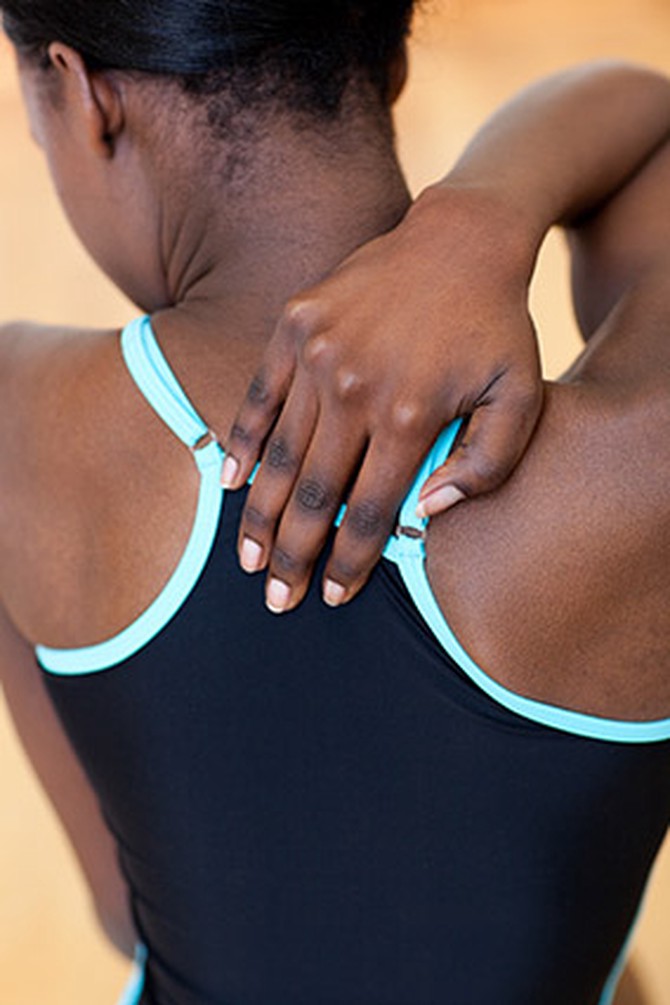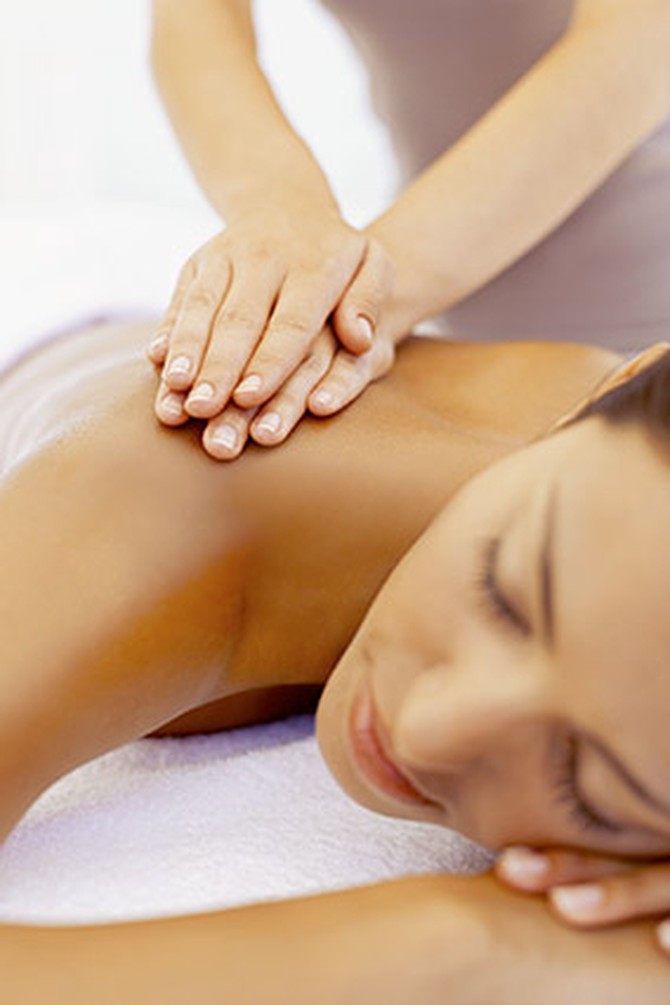Feeling Achy? The Body Part You Don't Know You Have
This mystery tissue could be what's making you feel stiff, creaky...and baffled.
By Corrie Pikul

Photo: Thinkstock
You're Achy, You're Sore, and You Have No Idea Why
It feels like muscle pain, but unlike a tight hamstring that makes you yelp when you stand up, your ache isn't triggered by a particular movement, and you can feel it in different places at various times. The culprit could be your fascia (pronounced "fash-ya"), says Mary Ann Wilmarth, DPT, chief of physical therapy at Harvard University Health Services. This sheet of tissue, made up of densely packed protein fibers, weaves throughout the entire body, and it binds and supports your muscles, bones and even your organs. While bodywork specialists have been passionate about fascia for decades, Wilmarth says it took new research on how fascia and muscles work together (some of it presented at the first international fascia research conference at Harvard in 2007) to get different health pros—from orthopedists to MDs and pain experts to personal trainers—to catch on.

Photo: Wavebreakmedia Ltd/Thinkstock
How Fascia Makes You Feel
You have six times as many sensory neurons loaded in your fasciae as in any other tissue of your body except for your skin, explains Jill Miller, a fitness expert and longtime fascia evangelist (she's an experienced registered yoga teacher, has presented case studies at fascia research conferences and developed the Roll Model fascia therapy program). This internal webbing helps different muscle systems communicate with one another—they're what make you want to get out of your office chair and stretch or roll your neck around. Ideally, your fascias should be supple enough to slide, glide, twist and bind like long, thin sheets of rubber. When they're not functioning properly, signals from the nerve endings are muffled or muted (so you don't feel comfortable in your own body) or they're interpreted by your brain as pain and discomfort.
Next: What to do before getting out of bed, what's causing that "crunchy" sound in your shoulders and more.
Next: What to do before getting out of bed, what's causing that "crunchy" sound in your shoulders and more.

Photo: Thinkstock
Find Your Inner Feline
You know how your muscles feel cramped and stiff when you wake up in the morning? After a night's sleep (or another long period of inactivity, like a car trip or plane ride), the parts of your fascia that wrap around and through your muscle fibers, which are normally stretchy and flexible, can stick together like previously chewed Hubba Bubba.
The fix: The best way to release the fascia is to slowly and luxuriously stretch out your arms and legs and roll slowly from side to side before getting out of bed. This will gently pull the muscles apart and separate the connecting tissue, Wilmarth says. To get at the fascia in your calves, ankles and arches, sit on the edge of the bed and flex and point your feet before putting the pressure of your weight on them.
The fix: The best way to release the fascia is to slowly and luxuriously stretch out your arms and legs and roll slowly from side to side before getting out of bed. This will gently pull the muscles apart and separate the connecting tissue, Wilmarth says. To get at the fascia in your calves, ankles and arches, sit on the edge of the bed and flex and point your feet before putting the pressure of your weight on them.

Photo: Thinkstock
Roll It Out Like Bread Dough
Fascia can be finicky: It gets stiff and sticky when you don't move around enough, but it can also get bound up and twisted when you move too much or do repetitive motion or injure yourself through activity, says James L. Thornton, the president of the National Athletic Trainers Association.
The fix: Work out overused sore spots with a foam roller. You've probably seen people at the gym using these things, which look like pool noodles, to stretch their back, hamstrings and the notoriously tight IT band on the outside of the hips (this video from Jeff Richter, a certified strength and conditioning coach at St. Vincent Sports Performance in Indianapolis, provides a good foam-roller tutorial). Thornton says to go slowly, and when you get to a sore spot that feels like a bruise, pause for 15 to 20 seconds. The discomfort should melt away as the fascia softens and the muscles release. If you feel intense pain that doesn't dissipate, Thornton says to stop and consider making an appointment with a physical therapist. At home, you can give yourself a massage with tennis balls or Yoga Tune Up balls, which grip the skin to help loosen up individual layers of fascia. Also try a device called the Stick. It lets you really go deep into your calves, shins and hamstrings, but because it's more rigid than a foam roller, the Stick can feel much more intense (think deep-tissue massage versus regular rubdown).
The fix: Work out overused sore spots with a foam roller. You've probably seen people at the gym using these things, which look like pool noodles, to stretch their back, hamstrings and the notoriously tight IT band on the outside of the hips (this video from Jeff Richter, a certified strength and conditioning coach at St. Vincent Sports Performance in Indianapolis, provides a good foam-roller tutorial). Thornton says to go slowly, and when you get to a sore spot that feels like a bruise, pause for 15 to 20 seconds. The discomfort should melt away as the fascia softens and the muscles release. If you feel intense pain that doesn't dissipate, Thornton says to stop and consider making an appointment with a physical therapist. At home, you can give yourself a massage with tennis balls or Yoga Tune Up balls, which grip the skin to help loosen up individual layers of fascia. Also try a device called the Stick. It lets you really go deep into your calves, shins and hamstrings, but because it's more rigid than a foam roller, the Stick can feel much more intense (think deep-tissue massage versus regular rubdown).

Photo: Thinkstock
Stretch It Out
You've heard that before exercising, it's a good idea to do some dynamic stretching that includes swinging your legs and arms to improve your range of motion. This not only benefits your muscles, says Thornton, but it's also a great way to loosen up your fascia. When your muscles stay tight, the fascia clings to them, and both can become rigid over time.
The fix: Take a brisk walk or jog lightly in place, and do some sports-specific moves (for example, leg swings for runners, or shoulder rolls for swimmers). Or try the lazy woman's warm-up: Start your workout, and stay at a slow, easy, I could-do-this-for-hours pace for about 5 minutes.
The fix: Take a brisk walk or jog lightly in place, and do some sports-specific moves (for example, leg swings for runners, or shoulder rolls for swimmers). Or try the lazy woman's warm-up: Start your workout, and stay at a slow, easy, I could-do-this-for-hours pace for about 5 minutes.

Photo: Thinkstock
Don't Let the Tissues Get "Crunchy"
If you've ever had a shoulder rub and heard something that sounded like crinkling plastic under your skin, that wasn't your imagination—it was probably your parched, stiffened fascia, says Ruth Werner, a past president of the Massage Therapy Foundation, who spent decades teaching anatomy and physiology to other therapists. The collagen fibers that make up fascia need to stay supple to work properly, and to slide over and under muscles and other inner-body surfaces.
The fix: One way to keep the fascia hydrated is obvious: drink lots of fluids, says Werner. Another easy (but easily forgettable) way is to make sure you stand up, stretch and flex regularly throughout the day to keep the fascia from locking up. Werner says some research has also shown that rubbing tight areas—as when you get a massage—can boost circulation and warm the fascia, changing the texture to make it even more pliable.
The fix: One way to keep the fascia hydrated is obvious: drink lots of fluids, says Werner. Another easy (but easily forgettable) way is to make sure you stand up, stretch and flex regularly throughout the day to keep the fascia from locking up. Werner says some research has also shown that rubbing tight areas—as when you get a massage—can boost circulation and warm the fascia, changing the texture to make it even more pliable.

Photo: Thinkstock
Let the Pros Handle It
Because fascia is so interconnected, snags—or adhesions, as pros call them—in one area can affect other other areas. "Imagine putting on multiple layers of long-sleeve shirts, and then think about how tugging on one of them would cause all of the other shirts to pull and stretch as well," says Cynthia Ribeiro, the president of the American Massage Therapy Association and a massage therapist. She stresses that you can't have healthy muscles without well-cared-for fascia.
The fix: There are different therapeutic methods to address keeping the fascia healthy, from intense, sometimes-excruciating Rolfing to gentle fascial unwinding to myofascial release, which usually involves loading the deeper tissues with force until they start to give. If you're chronically stiff and sore, or you have a muscle injury that just won't heal, consult a specialist to see what would be right for you. Massage therapists like Ribeiro and PTs like Wilmarth have seen clients for whom nothing seemed to work...until a type of fascial therapy helped melt away their pain and stiffness.
Next: 6 things most women don't know about their bodies
The fix: There are different therapeutic methods to address keeping the fascia healthy, from intense, sometimes-excruciating Rolfing to gentle fascial unwinding to myofascial release, which usually involves loading the deeper tissues with force until they start to give. If you're chronically stiff and sore, or you have a muscle injury that just won't heal, consult a specialist to see what would be right for you. Massage therapists like Ribeiro and PTs like Wilmarth have seen clients for whom nothing seemed to work...until a type of fascial therapy helped melt away their pain and stiffness.
Next: 6 things most women don't know about their bodies
Published 11/07/2014

